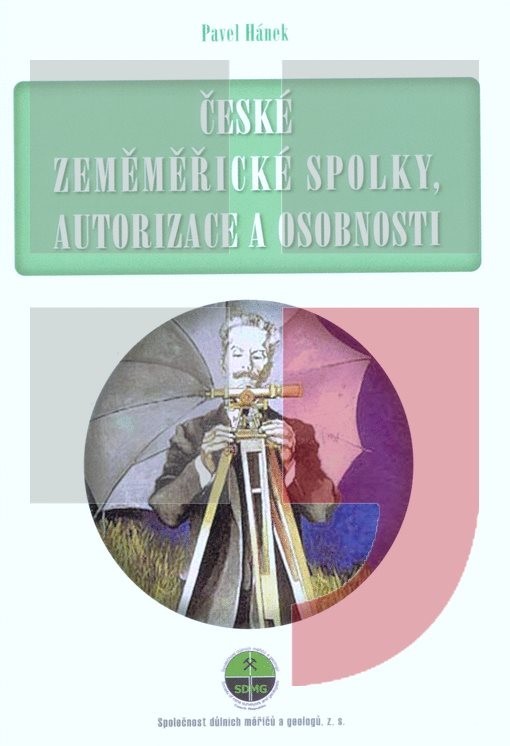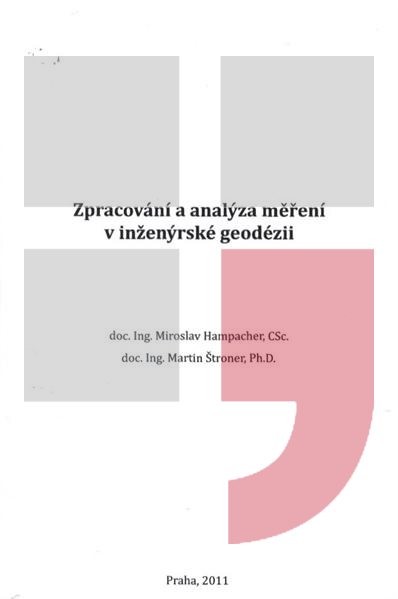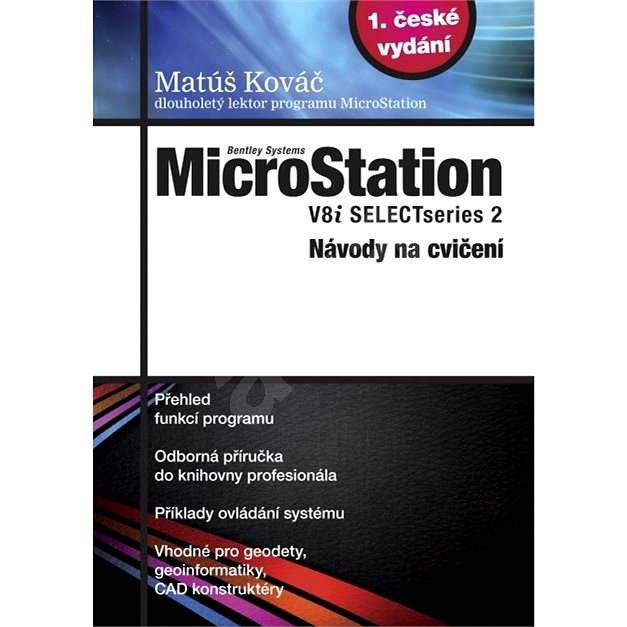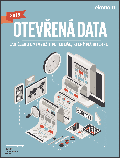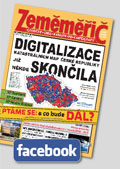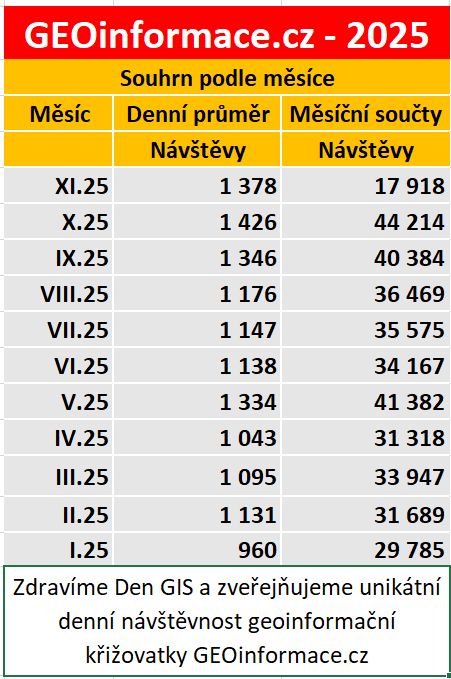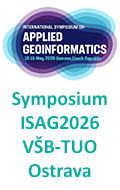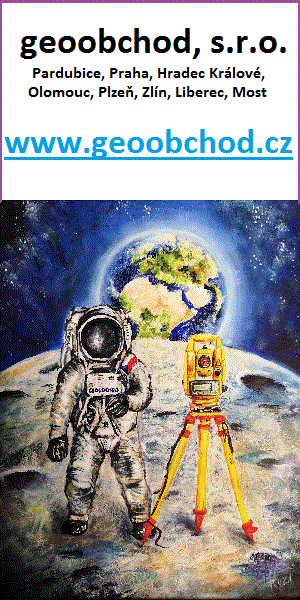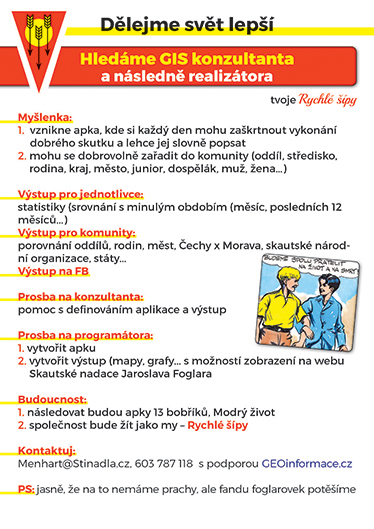zprávy
zdroje zpráv:První setkání diskusní platformy APG – ČÚZK
10.1.2019 21:46 Asociace podnikatelů v geomatice Uskutečnilo se první setkání společné diskusní platformy APG – ČÚZK. Tato platforma vznikla na základě domluvy mezi představiteli ČÚZK a APG. Prvního setkání se za ČÚZK zúčastnila ředitelka odboru řízení územních orgánů Martina Hercegová a Jan Kmínek, vedoucí oddělení metodiky zeměměřictví a katastru. Za APG byli přítomni Jaroslav Cibulka, Denisa Petříková, Jan Pěčonka, Jan Plavec. Po řešení řady […]Contra Costa Water District Selects Total Resource Management with Sedaru, Inc. for its Enterprise Asset & Operational Management System
10.1.2019 19:18 GISCafe.com Webcasts-Webinars Bay-Area utility serving 500,000 homes and businesses signs multi-year contractSAN DIMAS, Calif., Jan. 10, 2019 — (PRNewswire) —
SAN …
QYSEA Announced 3 Underwater AI Systems at CES 2019
10.1.2019 19:18 GISCafe.com Webcasts-Webinars LAS VEGAS, Jan. 10, 2019 — (PRNewswire) — Shenzhen QYSEA Technology Co., Ltd. (QYSEA), a leading company in underwater drone industry, …Sparx Systems Joins UN-GGIM Private Sector Network
10.1.2019 19:18 GISCafe.com Webcasts-Webinars Helping To Meet the United Nations 2030 Sustainable Development GoalsCRESWICK, Victoria, Jan. 10, 2019 — (PRNewswire) —
CRESWICK, …
Maxar's SSL Selected to Define Small Satellite Requirements for Environmental Defense Fund
10.1.2019 19:18 GISCafe.com Webcasts-Webinars PALO ALTO, CA, Jan. 10, 2019 — (PRNewswire) — SSL, a Maxar Technologies company (NYSE:MAXR) (TSX:MAXR), and a leading provider of …Hexagon Selected by Alectra Utilities for GIS Convergence Project
10.1.2019 19:18 GISCafe.com Webcasts-Webinars Project merges four separate systems into single network modelHUNTSVILLE, Ala., Jan. 10, 2019 — (PRNewswire) — Alectra Utilities, the …
Cold Turkey
10.1.2019 17:20 ESA Observing the Earth
While snow continues to cause chaos in Austria and Germany, the cold snap has also reached Turkey as shown in this Copernicus Sentinel-3 image
Geoinformace ve veřejné správě (GIVS) 2019
10.1.2019 16:29 GeoBusiness Česká asociace pro geoinformace pořádá dvanáctý ročníku konference Geoinformace ve veřejné správě 2019. Akce se uskuteční ve dnech 20. a 21. května v Praze. Tématy ... PřečístKatedra získala projekt TAČR na kulturní a kreativní průmysly
10.1.2019 15:58 Katedra geoinformatiky UP OlomoucKatedře se podařilo získat 2-letý projekt TAČR pod názvem “Výzkum motivací aktérů kreativních průmyslů v olomoucké aglomeraci a návrh strategie pro posílení segmentu”. Jedná se o interdisciplinární projekt napříč třemi fakultami za 4,2 miliónu korun, naše katedra je hlavním řešitelem, jedním z hlavním výstupů bude série specializovaných map a aplikací. Včerejší tisková konference měla ohlas […]
The post Katedra získala projekt TAČR na kulturní a kreativní průmysly appeared first on Katedra geoinformatiky.
Katedra získala projekt TAČR na kulturní a kreativní průmysly
10.1.2019 15:58 Katedra geoinformatiky UP OlomoucKatedře se podařilo získat 2-letý projekt TAČR pod názvem „Výzkum motivací aktérů kreativních průmyslů v olomoucké aglomeraci a návrh strategie pro posílení segmentu“. Jedná se o interdisciplinární projekt napříč třemi fakultami za 4,2 miliónu korun, naše katedra je hlavním řešitelem, jedním z hlavním výstupů bude série specializovaných map a aplikací. Včerejší tisková konference měla ohlas […]
The post Katedra získala projekt TAČR na kulturní a kreativní průmysly appeared first on Katedra geoinformatiky.
Copernicus Sentinel-1 maps Norway in motion
10.1.2019 15:30 ESA Observing the Earth
Images acquired every six days by the European Union’s Copernicus Sentinel-1 satellites are being used to map ground movement across two billion measurement sites in Norway, revealing shifts as small as one millimetre a year.
vrchní referent/rada - obnova katastrálního operátu - v oddělení aktualizace KN Katastrálního pracov
10.1.2019 14:41 ČÚZK /Urady/Katastralni-urady/Katastralni-urady/Katastralni-urad-pro-Jihocesky-kraj/Uredni-deska/Oznameni-a-jina-uredni-sdeleni/Volna-mista/vrchni-referent-rada-obnova-katastralniho-operatvrchní referent/rada - obnova katastrálního operátu - v oddělení aktualizace KN Katastrálního pracov
10.1.2019 14:41 ČÚZK - volná místa Katastrální úřad pro Jihočeský kraj - Katastrální pracoviště Strakonice vypisuje výběrové řízení na místo vrchní referent/rada - obnova katastrálního operátu - v oddělení aktualizace KN Katastrálního pracovvrchní referent/rada - obnova katastrálního operátu - v oddělení aktualizace KN Katastrálního pracov
10.1.2019 14:41 ČÚZK - předpisy a opatření Katastrální úřad pro Jihočeský kraj - Katastrální pracoviště Strakonicevypisuje výběrové řízení na místo
vrchní referent/rada - obnova katastrálního operátu - v oddělení aktualizace KN Katastrálního pracoviště Strakonice
rada/odborný rada v oddělení dokumentace KN – řízení o opravě chyby v SPI a údajů SGI - Katastrálníh
10.1.2019 14:27 ČÚZK /Urady/Katastralni-urady/Katastralni-urady/Katastralni-urad-pro-Jihocesky-kraj/Uredni-deska/Oznameni-a-jina-uredni-sdeleni/Volna-mista/rada-odborny-rada-v-odd-dokumentace-KN-PIrada/odborný rada v oddělení dokumentace KN – řízení o opravě chyby v SPI a údajů SGI - Katastrálníh
10.1.2019 14:27 ČÚZK - předpisy a opatření Katastrální úřad pro Jihočeský kraj - Katastrální pracoviště Písekvypisuje výběrové řízení na místo
rada/odborný rada v oddělení dokumentace KN – řízení o opravě chyby v SPI a údajů SGI - Katastrálního pracoviště Písek
rada/odborný rada v oddělení dokumentace KN – řízení o opravě chyby v SPI a údajů SGI - Katastrálníh
10.1.2019 14:27 ČÚZK - volná místa Katastrální úřad pro Jihočeský kraj - Katastrální pracoviště Písek vypisuje výběrové řízení na místo rada/odborný rada v oddělení dokumentace KN – řízení o opravě chyby v SPI a údajů SGI - KatastrálníhRada / odborný rada – obnova katastrálního operátu v oddělení aktualizace a dokumentace KN
10.1.2019 13:49 ČÚZK - předpisy a opatření Katastrální úřad pro Zlínský kraj - Katastrální pracoviště Valašské Kloboukyvypisuje výběrové řízení na místo
Rada / odborný rada – obnova katastrálního operátu v oddělení aktualizace a dokumentace KN
Rada / odborný rada – obnova katastrálního operátu v oddělení aktualizace a dokumentace KN
10.1.2019 13:49 ČÚZK /Urady/Katastralni-urady/Katastralni-urady/Katastralni-urad-pro-Zlinsky-kraj/Uredni-deska/Oznameni-a-jina-uredni-sdeleni/Volna-mista/Rada-odborny-rada-–-obnova-katastralniho-operatuRada / odborný rada – obnova katastrálního operátu v oddělení aktualizace a dokumentace KN
10.1.2019 13:49 ČÚZK - volná místa Katastrální úřad pro Zlínský kraj - Katastrální pracoviště Valašské Klobouky vypisuje výběrové řízení na místo Rada / odborný rada – obnova katastrálního operátu v oddělení aktualizace a dokumentace KNHelping the visually impaired explore the outdoors
10.1.2019 13:41 European GNSS Agency
On 3 December, as part of the International Day of Persons with Disabilities, Geko Navsat inaugurated the first accessible urban park using its Blind Explorer sensorial guidance solution.
With one in 30 people in Europe experiencing vision loss, innovator Rafael Olmedo had an idea: pair sound cues with augmented satellite navigation signals to help the visually impaired navigate along a predefined track. He called it 3SOUND.
“The idea behind the 3SOUND system was to provide an acoustic track perception based on the integration of an augmented acoustic reality application developed for a smartphone and an accurate and reliable navigation solution based on the use of GNSS signals augmented with EGNOS,” explains Olmedo. “The system would accurately identify the position and orientation of the user and, using binaural sounds, provide an innovative acoustic guidance solution for track navigation instead of the classical waypoint or route navigation.”
As the winner of the GSA Special Prize at the 2012 European Satellite Navigation Competition, the idea was first promoted at a special event organised by the GSA, ‘Space Solutions for Assisted Living’ held in London on the International Day of Persons with Disabilities, 3 December 2012. Thanks to GSA support, Olmedo was able to further develop the 3SOUND idea at a business incubation centre in Madrid. Here, he founded Geko Navsat, a start-up dedicated to transforming the 3SOUND concept into a market-ready solution.
The great outdoors
Out of this work came Blind Explorer, an application that provides an accurate and reliable, personal navigation solution to guide people with visual impairments along unknown paths. To do this, it uses sensory interfaces that improve the user’s autonomy, safety and experience. “This is the first guidance system based on binaural, or 3D, sounds and advanced satellite navigation technologies, including Galileo,” explains Olmedo. “Used together, these technologies provide the user with an intuitive perception of a course’s orientation and the ability to move in the right direction.”
Available on the Google Play and Apple App store, the Blind Explorer application is geared towards helping the visually impaired explore the outdoors by themselves. All the user has to do is a select a destination or route, which Blind Explorer refers to as ‘tracks’. From here, the app automatically generates 3D sound cues to enable the acoustic perception of the right direction. All sounds and guidance indications can be customised in accordance with the user’s specific needs.
Another feature allows users to record their own tracks or points of interests with just the press of a button. These routes can then be shared with other users, thus growing the network of available routes. For those needing higher accuracy than what is provided by the smartphone, Blind Explorer can be enhanced using an external GNSS Bluetooth.
First tracks launched – more to come
In celebration of the International Day of Persons with Disabilities on 3 December, Geko Navsat launched its first batch of accessible urban park routes for the Blind Explorer solution. The initial rollout includes 15 routes in five urban parks located in the Madrid region. “Blind Explorer provides all the information about these reliable and quality routes,” says Olmedo. “You can consult route details, select the preferred one and activate the navigation to walk the route and discover its points of interests – even when outside of cellular coverage.”
These initial routes are just the beginning – as Olmedo and his team plan to add more parks and routes from across Europe. “Historically, the visually impaired have had limited options for outdoor activities and tourism,” he adds. “Blind Explorer is changing that by providing both tourism providers and visually impaired tourists with an accurate navigation system for discovering the outdoors independently.”
Media note: This feature can be republished without charge provided the European GNSS Agency (GSA) is acknowledged as the source at the top or the bottom of the story. You must request permission before you use any of the photographs on the site. If you republish, we would be grateful if you could link back to the GSA website (http://www.gsa.europa.eu).
Informace o výsledcích kontrol dle § 26 zákona č. 255/2012 Sb. za rok 2018
10.1.2019 13:17 ČÚZK - předpisy a opatření Zeměměřický a katastrální inspektorát v Prazevydává informace o výsledcích kontrol dle § 26 zákona č. 255/2012 Sb. za rok
2018
Výroční zpráva dle zákona č. 106/1999 Sb. za rok 2018
10.1.2019 13:09 ČÚZK /Urady/Zememericke-a-katastralni-inspektoraty/Zememericke-a-katastralni-inspektoraty/Zememericky-a-katastralni-inspektorat-v-Praze/Vyrocni-zpravy/Vyrocni-zprava-dle-zakona-c-106-1999-Sb-za-rok-(1)Výroční zpráva dle zákona č. 106/1999 Sb. za rok 2018
10.1.2019 13:09 ČÚZK - předpisy a opatření Zeměměřický a katastrální inspektorát v Prazevydává výroční zprávu o činnosti ZKI v Praze v oblasti poskytování informací dle zákona č.106/1999 Sb., o svobodném přístupu k informacím v platném znění
2018
Revize KN
10.1.2019 11:30 ČÚZK /Urady/Katastralni-urady/Katastralni-urady/Katastralni-urad-pro-Ustecky-kraj/Katastralni-pracoviste/KP-Teplice/O-uradu/Aktuality/Revize-KN-(5)Revize KN
10.1.2019 11:30 ČÚZK - předpisy a opatření Katastrální úřad pro Ústecký kraj - Katastrální pracoviště Teplice zveřejnil novou aktualitu: Vážení klienti, oznamujeme Vám, že od 11.3.2019 - do 30.11.2019 bude probíhat v katastrálním území Nová Ves u Teplic obce Teplijce revize katastru nemovitostí. Účelem provádění revize je soulad údajů katastru nemovitostí se skutečným stavem v terénu, kdy jsou zjišťovány změny a ověřován dosavadní stav předmětu evidence katastru nemovitostí.Revize KN
10.1.2019 11:29 ČÚZK /Urady/Katastralni-urady/Katastralni-urady/Katastralni-urad-pro-Ustecky-kraj/Katastralni-pracoviste/KP-Teplice/O-uradu/Aktuality/Revize-KN-(4)Revize KN
10.1.2019 11:29 ČÚZK - předpisy a opatření Katastrální úřad pro Ústecký kraj - Katastrální pracoviště Teplice zveřejnil novou aktualitu: Vážení klienti, oznamujeme Vám, že od 11.3.2019 - do 30.11.2020 bude probíhat v katastrálním území Teplice-Řetenice obce Teplice revize katastru nemovitostí. Účelem provádění revize je soulad údajů katastru nemovitostí se skutečným stavem v terénu, kdy jsou zjišťovány změny a ověřován dosavadní stav předmětu evidence katastru nemovitostí.Konference Trimble Express 2019
10.1.2019 11:27 Geotronics GEODÉZIE - Nahlédněte do budoucnosti světa inovativních technologií a řešení Trimble.Revize KN
10.1.2019 11:27 ČÚZK /Urady/Katastralni-urady/Katastralni-urady/Katastralni-urad-pro-Ustecky-kraj/Katastralni-pracoviste/KP-Teplice/O-uradu/Aktuality/Revize-KN-(3)Revize KN
10.1.2019 11:27 ČÚZK - předpisy a opatření Katastrální úřad pro Ústecký kraj - Katastrální pracoviště Teplice zveřejnil novou aktualitu: Vážení klienti, oznamujeme Vám, že od 11.3.2019 - do 30.11.2019 bude probíhat v katastrálním území Lahošť obce Lahošť revize katastru nemovitostí. Účelem provádění revize je soulad údajů katastru nemovitostí se skutečným stavem v terénu, kdy jsou zjišťovány změny a ověřován dosavadní stav předmětu evidence katastru nemovitostí.Revize KN
10.1.2019 10:52 ČÚZK - předpisy a opatření Katastrální úřad pro Ústecký kraj - Katastrální pracoviště Teplice zveřejnil novou aktualitu: Vážení klienti, oznamujeme Vám, že od 11.3.2019 - do 30.11.2019 bude probíhat v katastrálním území Fojtovice u Krupky obce Krupka revize katastru nemovitostí. Účelem provádění revize je soulad údajů katastru nemovitostí se skutečným stavem v terénu, kdy jsou zjišťovány změny a ověřován dosavadní stav předmětu evidence katastru nemovitostí.Vrchní referent/rada v oddělení obnovy katastrální operátu a revize KN na Katastrálním pracovišti B
10.1.2019 10:49 ČÚZK - předpisy a opatření Katastrální úřad pro Jihomoravský kraj - Katastrální pracoviště Brno-venkovnabízí služební místo
Vrchní referent/rada v oddělení obnovy katastrální operátu a revize KN na Katastrálním pracovišti Brno-venkov
Vrchní referent/rada v oddělení obnovy katastrální operátu a revize KN na Katastrálním pracovišti B
10.1.2019 10:49 ČÚZK /Urady/Katastralni-urady/Katastralni-urady/Katastralni-urad-pro-Jihomoravsky-kraj/Volna-mista/Vrchni-referent-rada-v-oddeleni-obnovy-katastralniVrchní referent/rada v oddělení obnovy katastrální operátu a revize KN na Katastrálním pracovišti B
10.1.2019 10:49 ČÚZK - volná místa Katastrální úřad pro Jihomoravský kraj - Katastrální pracoviště Brno-venkov vypisuje výběrové řízení na místo Vrchní referent/rada v oddělení obnovy katastrální operátu a revize KN na Katastrálním pracovišti BRevize KN
10.1.2019 10:49 ČÚZK - předpisy a opatření Katastrální úřad pro Ústecký kraj - Katastrální pracoviště Teplice zveřejnil novou aktualitu: Vážení klienti, oznamujeme Vám, že od 11.3.2019 - do 30.11.2019 bude probíhat v katastrálním území Mohelnice u Krupky obce Krupka revize katastru nemovitostí. Účelem provádění revize je soulad údajů katastru nemovitostí se skutečným stavem v terénu, kdy jsou zjišťovány změny a ověřován dosavadní stav předmětu evidence katastru nemovitostí.Vedoucí oddělení – odborný rada v oddělení obnovy a revize KN na Katastrálním pracovišti Brno-venkov
10.1.2019 10:39 ČÚZK - předpisy a opatření Katastrální úřad pro Jihomoravský kraj - Katastrální pracoviště Brno-venkovvypisuje výběrové řízení na místo
Vedoucí oddělení – odborný rada v oddělení obnovy a revize KN na Katastrálním pracovišti Brno-venkov
Vedoucí oddělení – odborný rada v oddělení obnovy a revize KN na Katastrálním pracovišti Brno-venkov
10.1.2019 10:39 ČÚZK /Urady/Katastralni-urady/Katastralni-urady/Katastralni-urad-pro-Jihomoravsky-kraj/Uredni-deska/Oznameni-a-jina-uredni-sdeleni/Volna-mista/Vedouci-oddeleni-–-odborny-rada-v-oddeleni-obnovyVedoucí oddělení – odborný rada v oddělení obnovy a revize KN na Katastrálním pracovišti Brno-venkov
10.1.2019 10:39 ČÚZK - volná místa Katastrální úřad pro Jihomoravský kraj - Katastrální pracoviště Brno-venkov vypisuje výběrové řízení na místo Vedoucí oddělení – odborný rada v oddělení obnovy a revize KN na Katastrálním pracovišti Brno-venkov20190110-Aktualizoavný seznam ÚOZI
10.1.2019 9:01 ČÚZK /Aktuality-resort/2019/20190110-Aktualizoavny-seznam-UOZI20190110-Aktualizoavný seznam ÚOZI
10.1.2019 9:01 ČÚZK - předpisy a opatření Český úřad zeměměřický a katastrální zveřejnil novou aktualitu: Aktualizovaný seznam úředně oprávněných zeměměřických inženýrů.20190110-Aktualizoavný seznam ÚOZI
10.1.2019 9:01 ČÚZK - předpisy a opatření Český úřad zeměměřický a katastrální zveřejnil novou aktualitu: Aktualizovaný seznam úředně oprávněných zeměměřických inženýrů.Hexagon Selected by Alectra Utilities for GIS Convergence Project
10.1.2019 9:00 Hexagon Safety & Infrastructure Project merges four separate systems into single network modelHexagon Selected by Alectra Utilities for GIS Convergence Project
10.1.2019 9:00 Hexagon Safety & InfrastructureAlectra Utilities, the second-largest municipally owned electric utility in North America, has selected Hexagon’s Safety & Infrastructure division to merge the utility’s four separate geographic information systems (GIS) into a single, enterprise GIS built on Hexagon’s Intergraph G/Technology software.
Alectra Utilities was formed from the merger of Enersource, Horizon Utilities and PowerStream in 2017, followed by the acquisition of Brampton Hydro, to become the second largest municipally-owned electricity utility in North America based on total number of customers served. The project includes merging the four utilities’ distinct systems into a single, common data model and symbology; refactoring the numerous system interfaces and converting the GIS data, which will result in a single, enterprise system.
“Alectra Utilities needed an enterprise-level system-of-record to manage all of our GIS and network data,” said Mike Matthews, senior vice president of network services for Alectra Utilities. “Consolidating on Hexagon’s Intergraph G/Technology will result in streamlined business processes, standardized engineering practices, improved data quality and better service for our customers.”
With Intergraph G/Technology as its enterprise GIS and network model management solution, Alectra Utilities will expand its ability to monitor, report on and improve reliability and power quality. With a single network operating model that feeds single interfaces into other critical systems, like SCADA, AMI and CIS, the utility can reduce costs and improve efficiency.
“We’re honored that Alectra Utilities selected Hexagon after a 3-year competitive process,” said David Armstrong, vice president and general manager for Hexagon’s Safety & Infrastructure division in Canada. “This is the fourth large utility in Canada to commit to Hexagon’s utility GIS software after competitive review, joining ATCO Electric, FortisAlberta and Toronto Hydro. We’re committed to bringing proven, trusted and innovative technology solutions to our customers.”
Hexagon’s Safety & Infrastructure division has pioneered the development and application of location-based systems for electric, communications, water and gas companies for decades. The company supports hundreds of utilities and communications customers around the world with solutions for network engineering, network operations and other business functions.
Hexagon Selected by Alectra Utilities for GIS Convergence Project
10.1.2019 9:00 Hexagon Safety & Infrastructure Project merges four separate systems into single network modelHexagon Selected by Alectra Utilities for GIS Convergence Project
10.1.2019 9:00 Hexagon Safety & Infrastructure Project merges four separate systems into single network modelDružice Sentinel-5P zlepšuje denní předpověď ozónu
10.1.2019 8:22 Český Kosmický PortálOd nynějška jsou využívána měření stavu atmosférického ozónu prováděná misí GMES/Copernius Sentinel-5P v každodenních předpovědích kvality ovzduší.
Rada / odborný rada v oddělení dokumentace
10.1.2019 7:39 ČÚZK - volná místa Katastrální úřad pro Liberecký kraj - Katastrální pracoviště Semily vypisuje výběrové řízení na místo Rada / odborný rada v oddělení dokumentaceRada / odborný rada v oddělení dokumentace
10.1.2019 7:39 ČÚZK - předpisy a opatření Katastrální úřad pro Liberecký kraj - Katastrální pracoviště Semilyvypisuje výběrové řízení na místo
Rada / odborný rada v oddělení dokumentace
Rada / odborný rada v oddělení dokumentace
10.1.2019 7:39 ČÚZK /Urady/Katastralni-urady/Katastralni-urady/Katastralni-urad-pro-Liberecky-kraj/Uredni-deska/Oznameni-a-jina-uredni-sdeleni/Volna-mista/Rada-odborny-rada-v-oddeleni-dokumentaceProhlášení k situaci ohledně pozemkových úprav a uspořádání rozdrobeného pozemkového vlastnictví na Slovensku
10.1.2019 6:07 Zeměměřič Společné prohlášení stavovských a odborných organizaci sdružujících odborníky na pozemkové úpravy v SRMetadata - Česká geologická služba
10.1.2019 1:00 Cenia - Katalog metadat ČR - INSPIRE Katalogová služba typu CSW-2.0.2, kterou jsou poskytována metadata o datových zdrojích České geologické služby.Speciální mapy III. vojenského mapování
10.1.2019 1:00 Cenia - Katalog metadat ČR - INSPIRE Ortorektifikované Speciální mapy III. vojenského mapování v měřítku 1:75 000. Původní mapování probíhalo v 80. letech 19. století, následně však bylo provedeno několik aktualizací. Mapy v této datové sadě byly vydány v období těsně před nebo po druhé světové válce (1935 - 1938 a 1946 - 1947), ale zobrazují stav území nejčastěji z konce 20. a začátku 30. let minulého století. Nejnovější mapové listy již obsahují dotisk kilometrové sítě souřadnic S-JTSK nebo pro znázornění výškopisu kromě šrafování používají už i vrstevnice. Polohová přesnost speciálních map kolísá, existují znatelné lokální deformace, odchylky na některých místech dosahují přes 100 metrů.Pro zpracování bezešvého obrazu byly použity z převážné většiny již naskenované mapové listy speciálních map III. vojenského mapování vytvořené Laboratoří geoinformatiky Univerzity Jana Evangelisty Purkyně v Ústí nad Labem v rámci řešení projektu VaV pro Ministerstvo životního prostředí. Chybějící mapové listy 3955 Hradec Králové, 4060 Ostrava a 4061 Karviná byly získány ze soukromého archivu a naskenovány dodatečně prostřednictvím CENIA. Ortorektifikaci jednotlivých mapových listů pro CENIA vytvořila Slovenská agentúra životného prostredia. Sloučení mapových listů do výsledného bezešvého mapového obrazu provedla CENIA.Prohlížecí služba WMTS - Základní mapy ČR - měřítková řada Google Maps
10.1.2019 1:00 Cenia - Katalog metadat ČR - INSPIRE Prohlížecí služba WMTS-ZM_900913 je poskytována jako veřejná prohlížecí služba nad daty Základních map České republiky pro měřítka 1:10 000, 1:25 000, 1:50 000, 1:100 000 a 1:200 000. Je doplněna mapami České republiky v měřítku 1:500 000 a 1:1 000 000. Data jsou z důvodu optimalizace rychlosti služby poskytována formou mapových dlaždic. Tato služba je optimalizována pro použití v aplikacích, které využívají jako výchozí souřadnicový systém WGS 84 / Pseudo-Mercator (EPSG 3857 alias 900913) a vyžadují standardy Google Maps/Bing Maps/OSM pokud jde o nastavení měřítkové řady. Služba splňuje Technické pokyny pro INSPIRE prohlížecí služby v. 3.11 a zároveň splňuje standard OGC WMTS 1.0.0.APGEO - PRVNÍ SETKÁNÍ DISKUSNÍ PLATFORMY APG – ČÚZK
10.1.2019 1:00 Asociace podnikatelů v geomatice Uskutečnilo se první setkání společné diskusní platformy APG – ČÚZK. Tato platforma vznikla na základě domluvy mezi ...Ortofotomapa GEODIS
10.1.2019 1:00 Cenia - Katalog metadat ČR - INSPIRE Barevná ortofotomapa s prostorovým rozlišením 0,5 m, pokrývající celé území ČR, která byla vyhotovena z leteckých měřických snímků společnosti Geodis Brno, s r.o. Každoročně probíhá aktualizace jedné třetiny území ČR.Náhradní výsadba v k. ú. Vejprty
10.1.2019 0:00 Státní pozemkový úřad Státní pozemkový úřad realizuje nejen jednoduché a komplexní pozemkové úpravy, ale rovněž zajišťuje výsadby dřevin v rámci udržitelného rozvoje. Hlavním cílem udržitelného rozvoje je uvést v soulad hospodářský a společenský pokrok s plnohodnotným zachováním životního prostředí dalším generacím v co nejméně pozměněné podobě.Realizace polních cest HPC 1 v k. ú. Kryry a HPC 3R v k. ú. Vroutek
10.1.2019 0:00 Státní pozemkový úřad Pobočka Louny zajistila v roce 2018 realizaci polních cest v k. ú. Kryry a Vroutek podle schválených návrhů komplexních pozemkových úprav v katastrálních územích Kryry a Vroutek. Obě polní cesty na sebe vzájemně navazují a propojují obě obce.CES 2019 Unveils Next-Gen Innovation to the World
9.1.2019 22:47 GISCafe.com Webcasts-Webinars LAS VEGAS — (BUSINESS WIRE) — January 9, 2019 —The next generation of innovation is taking center stage this week at CES® …
Drone Delivery Canada Supports Transport Canada
9.1.2019 22:47 GISCafe.com Webcasts-Webinars TORONTO, Jan. 9, 2019 — (PRNewswire) — Drone Delivery Canada 'DDC or the Company' (TSX.V:FLT OTC:TAKOF), is pleased to expresses …ParaZero Announces Second Waiver for Flight Over People and Beyond Visual Line of Sight Operations
9.1.2019 22:47 GISCafe.com Webcasts-Webinars TEL AVIV, Israel, January 9, 2019 — (PRNewswire) — Drone safety systems company, ParaZero Technologies Ltd (ASX: PRZ), announced today …Minister Garneau unveils Canada's new drone safety regulations
9.1.2019 19:56 GISCafe.com Webcasts-Webinars OTTAWA, Jan. 9, 2019 — (PRNewswire) —Drone pilots to register their drones and obtain a pilot certificate by June 1, 2019
OTTAWA, …
Sonda Mars Express představuje divukrásný zimní Mars
9.1.2019 19:46 Český Kosmický PortálSnímek zachycuje něco, co vypadá jako velká plocha čerstvě napadeného sněhu - sen každého milovníka zimních sportů. Je ovšem poněkud z ruky: na fotografii je kráter pojmenovaný Koroljov, který se nachází na povrchu planety Mars. Snímek pořídila sonda ESA Mars Express.
Verizon CEO Hans Vestberg Keynotes 2019 Consumer Electronics Show
9.1.2019 16:16 GISCafe.com Webcasts-Webinars LAS VEGAS, Jan. 08, 2019 (GLOBE NEWSWIRE) -- In a keynote address at the 2019 Consumer Electronics Show (CES), Verizon Chief Executive Officer Hans …Erasmus 2019/2020
9.1.2019 12:45 Katedra geoinformatiky UP OlomoucZájemci o Erasmus pobyty se již mohou přihlašovat do výběrového řízení přes aplikaci erasmusplus.upol.cz. Podmínkou pro přihlášení do výběrového řízení je vytvoření přihlášky v aplikaci a připojení životopisu (cz nebo en) a motivačního dopisu (v en). Přihlášky budou přijímány do 12. 2. 2019. V následujícím týdnu pak bude vyhlášen termín samotného výběrového řízení, které bude probíhat […]
The post Erasmus 2019/2020 appeared first on Katedra geoinformatiky.
Aktualizace dat ÚAP od poskytovatele České radiokomunikace
9.1.2019 12:10 Plzeňský kraj V datech územně analytických podkladů Plzeňského kraje byla provedena kompletní aktualizace dat ve správě poskytovatele České radiokomunikace a.s..Odborný rada – vedoucí oddělení dokumentace katastru nemovitostí Katastrálního pracoviště Trutnov
9.1.2019 12:03 ČÚZK - volná místa Katastrální úřad pro Královéhradecký kraj - Katastrální pracoviště Trutnov vypisuje výběrové řízení na místo Odborný rada – vedoucí oddělení dokumentace katastru nemovitostí Katastrálního pracoviště TrutnovOdborný rada – vedoucí oddělení dokumentace katastru nemovitostí Katastrálního pracoviště Trutnov
9.1.2019 12:03 ČÚZK /Urady/Katastralni-urady/Katastralni-urady/Katastralni-urad-pro-Kralovehradecky-kraj/Uredni-deska/Oznameni-a-jina-uredni-sdeleni/Volna-mista/Odborny-rada-–-vedouci-oddeleni-dokumentace-katastOdborný rada – vedoucí oddělení dokumentace katastru nemovitostí Katastrálního pracoviště Trutnov
9.1.2019 12:03 ČÚZK - předpisy a opatření Katastrální úřad pro Královéhradecký kraj - Katastrální pracoviště Trutnovvypisuje výběrové řízení na místo
Odborný rada – vedoucí oddělení dokumentace katastru nemovitostí Katastrálního pracoviště Trutnov
Chybná data v ÚAP od poskytovatele České radiokomunikace
9.1.2019 12:00 Plzeňský kraj Dle informací společnosti České radiokomunikace a.s. byla jimi poskytovaná data do ÚAP v rámci všech jejich aktualizačních balíčků v posledním čtvrtletí roku 2018 polohově chybná až o 13 metrů vůči skutečnému stavu. Dnešním dnem byla tato data od poskytovatele České radiokomunikace zcela smazána a v datech ÚAP nahrazena aktuálními.Odborný referent v oddělení dokumentace katastru nemovitostí Katastrálního pracoviště Trutnov
9.1.2019 11:54 ČÚZK /Urady/Katastralni-urady/Katastralni-urady/Katastralni-urad-pro-Kralovehradecky-kraj/Uredni-deska/Oznameni-a-jina-uredni-sdeleni/Volna-mista/Odborny-referent-v-oddeleni-dokumentace-katastru-nOdborný referent v oddělení dokumentace katastru nemovitostí Katastrálního pracoviště Trutnov
9.1.2019 11:54 ČÚZK - volná místa Katastrální úřad pro Královéhradecký kraj - Katastrální pracoviště Trutnov vypisuje výběrové řízení na místo Odborný referent v oddělení dokumentace katastru nemovitostí Katastrálního pracoviště TrutnovOdborný referent v oddělení dokumentace katastru nemovitostí Katastrálního pracoviště Trutnov
9.1.2019 11:54 ČÚZK - předpisy a opatření Katastrální úřad pro Královéhradecký kraj - Katastrální pracoviště Trutnovvypisuje výběrové řízení na místo
Odborný referent v oddělení dokumentace katastru nemovitostí Katastrálního pracoviště Trutnov
OGC Calls for Participation in Major Innovation Testbed (Testbed-15)
9.1.2019 11:39 GISCafe.com Webcasts-Webinars Testbed-15 aims to explore new levels of interoperable geospatial data processing with a focus on data-centric security, federated clouds, service …Mapová aplikace ÚAP - aktualizace
9.1.2019 9:50 Jihočeský kraj Mapová aplikace Územně analytické podklady byla aktualizována k 8.1.2019.Esri byla v nezávislé analýze označena za technologického leadera v oblasti location intelligence
9.1.2019 9:27 ARCDATAAnalytická společnost Forrester ocenila Esri ve své zprávě zabývající se firmami v oblasti „location intelligence“, tedy v oblasti využívání prostorových dat. V analýze The Forrester Wave™: Location Intelligence Platforms, Q4 2018 Evaluation se například uvádí: „Vizí Esri v oblasti location intelligence je pomoci firmám zjistit, kde se co děje a proč, a získat tak obchodní výhodu. Esri rozšiřuje využití platformy ArcGIS z oblasti GIS, kde již dlouho dominuje, i na trh location intelligence.“
Esri ve zprávě dosáhla nejvyššího hodnocení v kategoriích strategie a přítomnost na trhu. V kategorii prostorová vizualizace a analýza pak získala nejlepší ohodnocení ze všech posuzovaných společností.
Jack Dangermond, prezident Esri, zprávu okomentoval: „Využití ArcGIS k analýze a vizualizaci prostorových dat ve veřejném sektoru má dlouhou tradici. Analýza společnosti Forrester podle nás potvrzuje, že jej lze jako páteřní systém úspěšně nasadit i v komerčním sektoru.“
Rada/odborný rada – správce informačních a komunikačních technologií SIKT03
9.1.2019 8:56 ČÚZK - předpisy a opatření Katastrální úřad pro Plzeňský kraj - odbor informatikyvypisuje výběrové řízení na místo
Rada/odborný rada – správce informačních a komunikačních technologií SIKT03
Rada/odborný rada – správce informačních a komunikačních technologií SIKT03
9.1.2019 8:56 ČÚZK /Urady/Katastralni-urady/Katastralni-urady/Katastralni-urad-pro-Plzensky-kraj/Uredni-deska/Oznameni-a-jina-uredni-sdeleni/Volna-mista/Rada-odborny-rada-–-spravce-informacnich-a-komunikRada/odborný rada – správce informačních a komunikačních technologií SIKT03
9.1.2019 8:56 ČÚZK - volná místa Katastrální úřad pro Plzeňský kraj - odbor informatiky vypisuje výběrové řízení na místo Rada/odborný rada – správce informačních a komunikačních technologií SIKT03odborný referent – návrh zápisu v katastru
9.1.2019 8:35 ČÚZK /Urady/Katastralni-urady/Katastralni-urady/Katastralni-urad-pro-Olomoucky-kraj/Uredni-deska/Oznameni-a-jina-uredni-sdeleni/Volna-mista/odborny-referent-–-navrh-zapisu-v-katastruodborný referent – návrh zápisu v katastru
9.1.2019 8:35 ČÚZK - volná místa Katastrální úřad pro Olomoucký kraj - Katastrální pracoviště Prostějov vypisuje výběrové řízení na místo odborný referent – návrh zápisu v katastruodborný referent – návrh zápisu v katastru
9.1.2019 8:35 ČÚZK - předpisy a opatření Katastrální úřad pro Olomoucký kraj - Katastrální pracoviště Prostějovvypisuje výběrové řízení na místo
odborný referent – návrh zápisu v katastru
odborný referent/vrchní referent – kontrola aktualizace
9.1.2019 8:27 ČÚZK - předpisy a opatření Katastrální úřad pro Olomoucký kraj - Katastrální pracoviště Přerovvypisuje výběrové řízení na místo
odborný referent/vrchní referent – kontrola aktualizace
odborný referent/vrchní referent – kontrola aktualizace
9.1.2019 8:27 ČÚZK - volná místa Katastrální úřad pro Olomoucký kraj - Katastrální pracoviště Přerov vypisuje výběrové řízení na místo odborný referent/vrchní referent – kontrola aktualizaceRozpočet úřadu za rok 2019
9.1.2019 5:59 ČÚZK - předpisy a opatření Katastrální úřad pro Jihočeský krajvystavuje rozpočet úřadu za rok
2019
Rozpočet úřadu za rok 2019
9.1.2019 5:59 ČÚZK /Urady/Katastralni-urady/Katastralni-urady/Katastralni-urad-pro-Jihocesky-kraj/Rozpocet/Rozpocet-uradu-za-rok-2019Rozpočet úřadu za rok 2018 po 10.ROP
9.1.2019 5:58 ČÚZK - předpisy a opatření Katastrální úřad pro Jihočeský krajvystavuje rozpočet úřadu za rok
2018
Rozpočet úřadu za rok 2018 po 10.ROP
9.1.2019 5:58 ČÚZK /Urady/Katastralni-urady/Katastralni-urady/Katastralni-urad-pro-Jihocesky-kraj/Rozpocet/Rozpocet-uradu-za-rok-2018-po-10-ROPParsons Acquires OGSystems
8.1.2019 23:09 GISCafe.com Webcasts-Webinars Geospatial Intelligence, Data Analytics Technology to Accelerate Growth StrategyPASADENA, Calif., Jan. 8, 2019 — (PRNewswire) — …
Sprint Curiosity™ IoT Helps Smart Mobile Machines Get Smarter Using Mapbox Precision Mapping
8.1.2019 23:09 GISCafe.com Webcasts-Webinars Advanced AI, Robotics and Autonomous Vehicle Services on Sprint's dedicated IoT network will adapt to the real world using highly accurate, detailed …Dell Delivers Purposeful PC and Software Innovations for a Seamless, Intuitive Experience
8.1.2019 23:09 GISCafe.com Webcasts-Webinars LAS VEGAS, Jan. 8, 2019 — (PRNewswire) — Consumer Electronics ShowLatitude 7400 2-in-1 - the world's smallest commercial 14" …
Novým ústředním ředitelem Státního pozemkového úřadu je Martin Vrba
8.1.2019 22:01 Zeměměřič Ředitelem Státního pozemkového úřadu se stal dosavadní ředitel jeho Sekce řízení ústředí. Vedením úřadu byl pověřen již v červenci loňského roku.Další El Niño na obzoru
8.1.2019 19:44 Český Kosmický PortálZdali klimatické změny povedou k zesílení jevu El Niño, je dosud předmětem sporů. Ale zatímco zástupci 200 zemí světa na konferenci COP24 pracovali na oživení závazků vyplývajících z Pařížské dohody (2015), experti dospěli k názoru, že je 75- až 80procentní pravděpodobnost jeho výskytu v příštích měsících.
CentralSquare Acquires Lucity: Adds Leading Enterprise Asset Management (EAM) Software to Industry’s Broadest, Smartest and Most Unified Public Administration Cloud Software Suite
8.1.2019 17:18 GISCafe.com Webcasts-Webinars Lucity’s GIS-powered Enterprise Asset Management (EAM) software cutswork order time by 78% and saves up to $30 million in hundreds of North …
Bristol Water renews annual subscription with Rezatec for access to the Rezatec Water Catchment Management geospatial portal
8.1.2019 17:17 GISCafe.com Webcasts-Webinars Harwell, Oxfordshire, 08th January 2019 – Rezatec, the leading provider of geospatial data analytics to the Infrastructure, Forestry and …CoreLogic Loan Performance Insights Find Delinquency Rates in October Dropped to the Lowest Level in at Least 18 Years
8.1.2019 17:17 GISCafe.com Webcasts-Webinars U.S. serious delinquency rate was the lowest since November 2006Total past due and serious delinquency rates were down …
Cepton’s New Vista Solutions Usher in the Next Wave of Autonomous Driving With High Resolution, Long-Range and Compact LiDAR
8.1.2019 17:17 GISCafe.com Webcasts-Webinars Leveraging the high-performance compute of the NVIDIA DRIVEautonomous vehicle platform, Cepton’s Vista-M and Vista-X LiDAR provide
…
Drone Aviation Selected by Prime Contractor for Exclusive Relationship; Initial Award Valued at $3.8 Million
8.1.2019 17:17 GISCafe.com Webcasts-Webinars JACKSONVILLE, FL, Jan. 08, 2019 (GLOBE NEWSWIRE) -- Drone Aviation Holding Corp. (OTCQB: DRNE) (“Drone Aviation” or the “Company”), a …AEE Collaborates with ModalAI to Bring Unprecedented Safety to Drones
8.1.2019 17:17 GISCafe.com Webcasts-Webinars AEE’s Mach 2 Exhibited at CES2019 Utilizing Qualcomm Flight ™ ProTaking Obstacle Avoidance to New Heights
LAS VEGAS …
Leica Biosystems Receives US Patent for RTF Extreme Speed Scanning Technology
8.1.2019 17:17 GISCafe.com Webcasts-Webinars VISTA, California, Jan. 8, 2019 — (PRNewswire) — Leica Biosystems, the global leader in pathology workflow solutions announced …LocusLabs Partners with IndoorAtlas to Provide Precise Indoor Location-Based Experiences
8.1.2019 17:17 GISCafe.com Webcasts-Webinars Alliance offers campuses and indoor/outdoor venues a complete micro-location platform available via any app, across any screen.OAKLAND, Calif., Jan. …
DJI Introduces A Smart Remote Controller With Built-In Display at CES 2019
8.1.2019 17:17 GISCafe.com Webcasts-Webinars Remote Lets Pilots Fly Newest Mavic Drones Without A Mobile DeviceNEW YORK, Jan. 8, 2019 — (PRNewswire) — DJI, the world's leader in …
Integrity & reliability of digital maps – have your say!
8.1.2019 16:30 European GNSS Agency
The European GNSS Agency (GSA) is organising a public consultation on the Integrity & Reliability of Digital Maps for Connected and Automated Driving, in connection with the recently published Commission Communication on Connected and Automated Mobility. This Communication addresses the need to investigate the integrity and reliability of digital maps in order to facilitate the deployment of fully automated and connected vehicles.
Digital maps are an essential building block to ensure a safe driving experience for highly automated driving and autonomous vehicles. Purpose-built maps will be produced that will be much more reliable and accurate than those used for traditional applications.
These digital maps will be enriched with information from public databases and sensor data from connected vehicles. Traffic information, such as speed limits or the real-time dynamics of traffic flow, will help the vehicle’s navigation system to anticipate upcoming road conditions and take decisions beyond what is enabled by the vehicle’s on-board sensors.
Key role for GNSS
Satellite navigation (GNSS), and in particular Galileo, plays a key role in providing precise and secure positioning in vehicle navigation technologies for driverless mobility. Moreover, GNSS is the primary sensor for building digital maps to provide very accurate positioning together with other sensors, such as LiDAR, for example.
Dynamic data pose specific problems, particularly given their real-time nature: they must be generated, validated and made available to the user equipment without delay. This makes their integrity validation more challenging, and their transmission can be subject to errors or disruptions affecting the overall reliability.
Addressing the issue
Currently, it is the navigation and map provider’s responsibility to ensure the integrity of its products and the reliability of the information provided by third-party suppliers. However, until now the maps have been mainly used to support navigation, giving information to the driver, rather than to support safety-related functions.
Some industry standards exist or are being developed for data exchange and map content, but there are currently no specific standards or certification procedures to assess map data quality characteristics, such as reliability, integrity, and traceability. This public consultation is a starting point in addressing this issue.
Have your say
The public consultation can be accessed here. It will be open until 27 January 2019, so make sure you have your say!
Media note: This feature can be republished without charge provided the European GNSS Agency (GSA) is acknowledged as the source at the top or the bottom of the story. You must request permission before you use any of the photographs on the site. If you republish, we would be grateful if you could link back to the GSA website (http://www.gsa.europa.eu).
Elite Products for the New Year: Constructech Announces the 2019 Top Products
8.1.2019 15:50 Bentley SystemsPress Coverage
PR Web, USA
Read the articleE-on Software Unveils a Bold New Brand Identity
8.1.2019 15:48 Bentley SystemsPress Coverage
AECCafe, USA
Read the articleE-on Software Takes Users to Cloud Nine with New Releases
8.1.2019 15:46 Bentley SystemsPress Coverage
AECCafe, USA
Read the articleBIM and reality modeling eliminate change orders for brownfield substation expansion
8.1.2019 15:43 Bentley SystemsPress Coverage
Between the Poles, USA
Read the articleRozšiřte náš tým! Hledáme nového kolegu na pozici referenta Geoinformatiky
8.1.2019 15:08 Český Kosmický PortálMáte nadšení do práce? Vyznáte se v GIS aplikacích a prostorových datech? Pak neváhejte a posilte náš tým na perspektivní pozici Geoinformatik!
Ředitel odboru - ředitel kanceláře ředitele KÚ
8.1.2019 13:12 ČÚZK - předpisy a opatření Katastrální úřad pro Liberecký krajvypisuje výběrové řízení na místo
Ředitel odboru - ředitel kanceláře ředitele KÚ
Ředitel odboru - ředitel kanceláře ředitele KÚ
8.1.2019 13:12 ČÚZK - volná místa Katastrální úřad pro Liberecký kraj vypisuje výběrové řízení na místo Ředitel odboru - ředitel kanceláře ředitele KÚŘeditel odboru - ředitel kanceláře ředitele KÚ
8.1.2019 13:12 ČÚZK /Urady/Katastralni-urady/Katastralni-urady/Katastralni-urad-pro-Liberecky-kraj/Uredni-deska/Oznameni-a-jina-uredni-sdeleni/Volna-mista/Reditel-odboru-reditel-kancelare-reditele-KURozpočet úřadu za rok 2019
8.1.2019 12:35 ČÚZK /Urady/Zememericke-a-katastralni-inspektoraty/Zememericke-a-katastralni-inspektoraty/Zememericky-a-katastralni-inspektorat-v-Liberci/Rozpocet/Rozpocet-uradu-za-rok-2019Rozpočet úřadu za rok 2019
8.1.2019 12:35 ČÚZK - předpisy a opatření Zeměměřický a katastrální inspektorát v Libercivystavuje rozpočet úřadu za rok
2019
Mapa administrativního členění
8.1.2019 12:30 Jihočeský kraj V sekci Ke stažení je k dispozici aktualizovaná mapa administrativního členění k 1. 1. 2019 v rozměru mapy A1 za Jihočeský kraj.Sentinel calendar
8.1.2019 12:30 ESA Observing the Earth
Download the 2019 Copernicus Sentinel calendar. Each month offers a spectacular view of our home planet captured by one of the Sentinel satellites
Request for Information: “Mixed Reality to the Edge” Concept Development Study
8.1.2019 11:57 GISCafe.com Webcasts-Webinars Study will explore the convergence of real world data with virtual 3d/4d environments for mobile and disconnected users.7 January 2019: As …
Odborný referent/vrchní referent – návrh zápisu v katastru NZK1104
8.1.2019 10:58 ČÚZK - volná místa Katastrální úřad pro Plzeňský kraj - Katastrální pracoviště Plzeň-sever vypisuje výběrové řízení na místo Odborný referent/vrchní referent – návrh zápisu v katastru NZK1104Odborný referent/vrchní referent – návrh zápisu v katastru NZK1104
8.1.2019 10:58 ČÚZK - předpisy a opatření Katastrální úřad pro Plzeňský kraj - Katastrální pracoviště Plzeň-severvypisuje výběrové řízení na místo
Odborný referent/vrchní referent – návrh zápisu v katastru NZK1104




